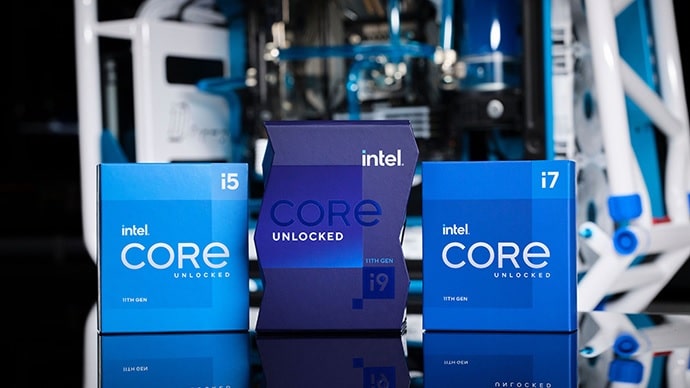Intel has unveiled its Rocket Lake-S desktop processors. This is the first time since 2015 that Intel has brought a new processor architecture to the desktop. However, the chips are still produced at 14 nanometres.
It is a series of new processors in the i5, i7 and i9 series. As with the previous generation, these are processors with 6, 8, and again 8 cores respectively, all with hyperthreading. The i9s lost two cores compared to their predecessors, but Intel says this is made up by a higher clock speed and ipc. Some new Celeron, Pentium and i3 processors have also been announced, but they are all still based on the older Skylake architecture.
The three main models of each series are the Core i5-11600, Core i7-11700 and Core i9-11900. All three models are also available in variants that are overclockable, have no igpu or have a lower tdp. These features are indicated with a K, F and T respectively after the type number. All these processors have variants with a maximum turbo speed of 5.3GHz. There are also two i5 versions with a lower clock speed, the i5-11500 and i5-11400.
Insufficient capacity at 10 nanometres?
The fact that the chips are still produced at 14 nanometres is remarkable. The Sunny Cove architecture is actually intended for 10 nanometres, but Intel has adapted it to work at 14 nanometres under the name Cypress Cove. According to Intel, this step was taken in order to achieve higher clock speeds, but it probably has more to do with persistent problems with the production of 10-nanometre wafers. Intel’s latest server processors and laptop processors, however, are made on the Sunny Cove 10nm architecture.
Faster than previous generation, higher power consumption too
Intel claims that the new architecture brings with it an IPC improvement of 19 percent over Skylake. However, Anandtech has already gotten an early hands-on with an i7-11700K, and tests show that although the new chips are indeed faster than their predecessors, that gain seems to be only a few percent. Moreover, the power consumption seems to be a lot higher. The new AMD 5800X, which has the same number of cores, performs better in almost all applications. On the other hand, with the current chip shortage, AMD processors are hard to come by, while Intel, with its own factories, is much less affected.
The new generation of Intel chips will be released on 30 March. Prices range from 160 euros for the i5-1400F to 548 euros for the i9-11900K. The non-overclockable i9-11900 is about 100 euros cheaper, with a suggested retail price of 446 euros.
